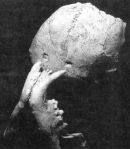Natural Terror | The Zucchini Patch
Update 9/22/2007: Jessica retooled her blog over the summer. Do be sure to check it out. Here’s the new link to the post above.
Natural Terror | The Zucchini Patch
A quick search for the toothmark photo below turned up a couple of interesting blog entries using the same photo. I include them here to bore the disinterested:
- Who, or What, Killed the Australopithicine? – which added the phrase “Osteodontokeratic industry” to my already useless vocabulary.
- IIDB > IIDB Philosophical Forums > Evolution/Creation > The wiring of the eye: Is it poor design? to which I answer, no, not a poor design but the prototype for the real thing – if we can evolve it before the Creationists destroy the world – to prevent it from happening, I suppose?
- IIDB > IIDB Philosophical Forums > Evolution/Creation > Early Humans on the Menu
One of Jessica’s recent posts reminded me of Paul Shepard’s eye-opening book, “The Others: How Animals Made Us Human.” Dr. Shepard was a Professor of Natural Philosophy and Human Ecology and wrote a number of books on our complex relationships with the earth and her other inhabitants.
Dr. Shepard was a Professor of Natural Philosophy and Human Ecology and wrote a number of books on our complex relationships with the earth and her other inhabitants.In “The Others,” Dr. Shepard’s focus is on the topic of domesticating animals. Originally our relationship with other species was simple. Either we ate that species, or we were eaten by it. Simplistic as it sounds, that has a profound impact on our central nervous systems, specifically the limbic system.
As an aside, domestication changed some species into status symbols, and it is possible to determine the social status of extended family members by whether they slept nearer or farther than the livestock.
In “Thinking Animals: Animals and the Development of Human Intelligence,” Dr. Shepard briefly discusses the neurotransmitters. Prey animals are hypervigilant, always watching and waiting for some unknown something to startle them into flight. Predators’ neurochemistry, however, mandates focus: moving slowly, with patience and determination, toward the object of their attention. What kind of animal can display both kinds of attention? It must require a wild mood swing to instantly change a creeping hunter into someone who is running at top speed from a predator. It is a huge shift from one neurochemical pathway to a completely different pathway, releasing a neurotransmitter and simultaneously inhibiting another. I believe that the ability to switch contexts was an important factor in our evolution.
No matter how much we have evolved both psychologically and culturally, the old systems are still wired in and still affect us. We are not a separate act of creation.
I’m sure that our protohominid ancestors were eaten by all manner of frightening creatures. Miss Bugs tells me that her ancestors, the sabre-toothed tigers, used to sneak up on our tiny Australopithecine ancestors, grab them by the head, and drag them home for the kittens to play with. Lower teeth puncture the back of the head, unwieldy canine teeth pierce the eyes. Physical anthropologists have found quite a few Australopithecus skulls with these puncture marks, as evidenced by the wonderful photo at right. Update 9/22: This early hominid skull was found in a cave at Swarkrans in the late 1930s. It wasn’t for another 30-some years that someone paused to reflect on the odd indentations in the skulls. We’ll leave the question about the skulls having indentations resembling early hominids’ stone tools for another time. This pausing to reflect takes a lot of effort!“The Others” is worth reading if only for the chapter on teddy bears as psychological bridges between the wild and the civilized. (I think housecats serve that purpose adequately.)
“Except possibly his soul, man prizes his mind above all else. His mind is a product of its ecology — the same ecology. Nothing that evolves persists unless sustained by those same creative forces. Like a ball at the top of a fountain, the human head pivots on its animal backbone, the mind a turning knot of thought and dream on the end of a liquid spear of living animals.” — Paul Shepard, “Thinking Animals”



 Bad Behavior
Bad Behavior Member of American Mensa, Ltd.
Member of American Mensa, Ltd. Church of the Flying Spaghetti Monster
Church of the Flying Spaghetti Monster Potential Threat To The Nation
Potential Threat To The Nation Amazon.com Daily Deals
Amazon.com Daily Deals